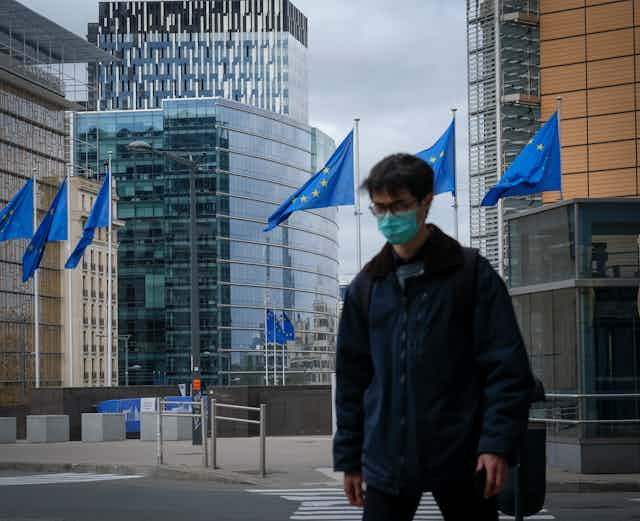In the event of a “natural or man-made disaster”, the European Union has a treaty-bound duty of solidarity. But the Italian president, Sergio Mattarella, has deplored the lack of help from other EU states in the early days of the crisis. Indeed, member states continue to disagree over the main financial package that will be needed to manage the economic fallout of the pandemic. But some other highly valuable work is being carried out by the EU and its states.
More than 500,000 citizens have been brought home by EU states. And when commercial flights have not been available, they have been able to activate the EU civil protection mechanism to bring back 53,000 Europeans stranded around the world.
The bloc has also supported a wider international effort to freeze developing countries’ debt for a year. It has approved a €20 billion support package to help countries around the world manage the crisis, including €3.25 billion for African nations. The Commission has proposed a €3 billion financial package in the form of loans to the Western Balkans, Jordan, Moldova, Tunisia and Ukraine. It has given €37 million as immediate support to the Balkans, and said it would reallocate €140 million for Armenia, Azerbaijan, Belarus, Georgia, Moldova and Ukraine.
Financial support to EU states
For its own members, the EU is working on a massive plan to provide one trillion euros to states in economic difficulty. This is considered vital for the survival of the European Union. Its member states are struggling to agree on whether financial support should be given as loans or grants but the German chancellor, Angela Merkel, has said she would consider backing EU bonds through a bigger EU budget – this would mean direct funds for states.
The EU has suspended member states’ growth obligations to allow them to spend billions of euros to mitigate the economic crisis. EU state aid rules have been relaxed, so states can provide support to their own companies. The European Central Bank announced it would spend €750 billion in bond purchases to relieve government debt. The EU put forward a €540 billion support package to tackle the crisis and support workers and businesses. It will make available temporary assistance of up to €100 billion for companies to ensure that employees keep their jobs.
Then there is funding for research related to the virus. The EU offered a guaranteed loan of €80 million to the German company CureVac to prevent it from being bought by the United States. The European Commission has allocated €48 million to 18 research projects. It is also planning to spend €90 million on the Innovative Medicines Initiative for research on therapeutics and diagnostics (not on preventive vaccines), and private companies working on a virus will be able to apply for funding from the European Innovation Council’s €164 million budget. Another €37 billion from existing EU structural funds is going towards supporting healthcare, businesses and workers through the Coronavirus Response Investment Initiative.

Equipment
The supply of personal protection equipment got off to a rocky start, with different countries refusing to supply to each other or work together. This was despite the fact that the EU coordinated the supply of 12 tons of PPE to China in February 2020.
However, there is now far greater coordination. The Commission eventually convinced Germany and France to authorise exports of medical equipment from their own states to other EU states. In addition, member states must now authorise their own companies to export medical equipment to non-EU countries. The Commission has waived customs duties and VAT on the import of medical equipment from non-EU countries.
New rules also mean that member states can request financial assistance for health emergencies (up to €800 million) from the EU Solidarity Fund. An EU-organised joint procurement scheme provides personal protective equipment to member states (the UK controversially refused to take part in this scheme). It has a similar scheme for respiratory ventilators and testing kits, but these have not yet arrived.
In March 2020, the Commission announced the EU would provide 90% of the funding to stockpile €50 million worth of medical equipment. The EU allocated all two million surgical masks, 200,000 N95 masks and 50,000 testing kits it ordered from China to Italy. In Greece, 500 mobile medical units co-financed by the EU will soon test citizens at their homes.
In early April 2020, a team of European doctors and nurses from Romania and Norway, deployed through the EU Civil Protection Mechanism, was sent to Italy. Independently of the EU initiatives, Austria, Germany and Luxembourg have made their intensive care units available to Dutch, French and Italian patients.
Germany is taking care of 200 patients from other EU states and both Poland and Germany have sent teams of doctors to help treat patients in hospitals in Italy. Denmark is sending ventilators and field hospital equipment to Italy.
The Czech Republic delivered 20,000 protective suits to Italy and Spain. France has donated one million masks to Italy and 20,000 protective suits. Germany has delivered 300 ventilators to Italy, and 60 to the UK (a ventilator costs $25,000).
Despite all this, the EU could do more. It could establish a common position on testing, contact tracing, isolation, social distancing (including mask wearing), and treatment. It could do much more to learn from those states dealing relatively well with the epidemic, such as China, South Korea, Singapore, Hong Kong, Vietnam, New Zealand, Portugal, Greece and Germany. And it could encourage states to increase the wages of its care workers.
EU state leaders could also even decide to supranationalise health policies – that is, transfer power to EU institutions in order to have a common health policy. They could follow the steps of the founding members of the European Communities, when they decided to supranationalise trade policies in 1957. By doing so, there would be better chances to ensure a common and immediate response to future health emergencies.

